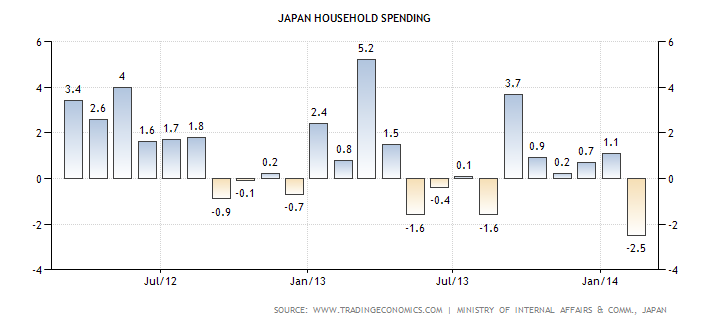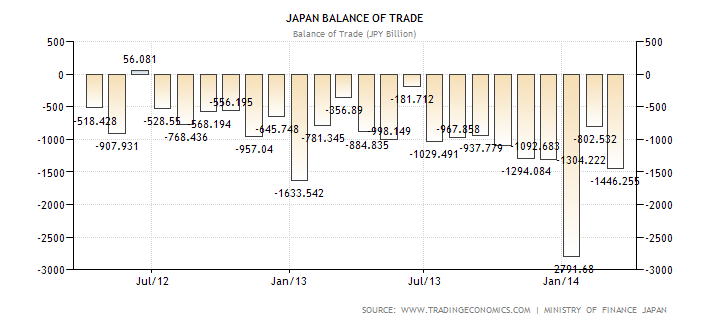The plan by Japanese Prime Minister Abe to boost his country’s economy and end deflation is looking increasingly shaky in the wake of another huge annual trade deficit.
It’s a vital plan for Japan, Australia’s second most important export market. Without it, the country will continue to wallow in a shallow deflationary rut.
The rise on April 1 in the country’s consumption tax seems certain to drag the economy into a slowdown this quarter because of an expected sharp contraction in consumer spending and business investment.
That is not expected to last more than this quarter, but it comes as the country’s huge export sector continues to underperform – and if anything, is starting to lose momentum, despite the sharp fall in the yen.
The Abe plan is designed to boost inflation by cutting the value of the yen and raising domestic demand, via higher household consumption and business investment.
To do that the country’s central bank has been buying tens of billions of dollars of securities (bonds of all kinds and some exchange traded funds) to pump enough money into the economy to trigger a surge in inflation.
The Bank of Japan kicked off its buying a year ago this month.
That was five months after the Abe government outlined its plan to boost the performance of the economy by ending deflation and weakening the yen’s value so that exports and investment would rise.
That has happened – inflation has replaced deflation, as we will have again confirmed this Friday with the March inflation data due for release.
But business investment remains weak and household spending has not been that solid – and will have to withstand the impact of the needed boost in the country’s consumption tax on April 1 from 5% to 8%.

In fact employers have been reluctant to lift wages in the past year – a key requirement of the government’s plan – to in turn boost household consumption.
But the tsunami in March 2011 and subsequent Fukushima nuclear plant crisis which led to the country’s 50 plus nuclear power stations having to close, has conspired to undermine the plan, along with weak decision-making by Japanese companies, large and small, who have been very slow to boost investment and exports.
So Japan’s trade performance, once the strongest in the world, has weakened since 2011 as the impact of the closure of the nuclear power stations and then the huge spending plan (which has weakened the value of the yen) have combined to create massive trade deficits – culminating in the record $US134 billion reported for the year to March 31 (which is Japan’s financial year).
The yen is now down 19% since Mr Abe came to power in 2011 (it was down 30% or more at one stage) and this, plus the required higher imports of fuels, such as LNG, means the country has been running trade deficits for the past 21 months.
The $US134 billion deficit was up more than 60% on the previous year, according to government data released yesterday.
It was the third consecutive year of deficits, the longest streak of red ink for the country’s trade account since comparable records began in the 1970s.

Overall Japanese exports increased by just 0.6% by volume in 2013-14, and the weaker yen boosted their value by 10.8%. Imports rose 2.4% by volume, but the weaker currency saw their value soar a massive 17% over the year.
In the March quarter export volumes fell slightly – by 0.2% quarter on quarter and were 2.5% lower than for March 2013 – a further indicator of the weakness of the performance by the country’s exporters.
The tax rise on April 1 was one reason for the surge in imports in the final quarter.
March’s deficit jumped to around $US14.1 billion as imports jumped 18%, double the 9% increase in February.
But exports only edged up 1.8% in value in the month, down from the 9.8% jump in February. That suggested another weak month for Japanese exporters.
The impact of the nuclear power station shutdown can’t be underestimated – Japanese power companies have been forced to import more LNG, coal and oil to replace the lost output from the nuclear stations.
The weaker yen has made each barrel that much pricier. Fuel imports jumped 18% by value in the year to March, according to latest trade data.
The tax rise looks certain to have a negative impact on the Japanese economy – data out on Monday showed a 9.4% jump in department store sales in March – the highest for a decade, as consumers brought forward purchases to take advantage of the lower tax rate before the April 1 rise.
The figures show that sales of household goods soared 22% from March 2013 and 41% from February – meaning they will almost certainly collapse this month and in May.
That will help pull the economy back into negative growth for the current quarter, while the surge in sales in March (business sales reportedly have risen as well) will boost the GDP figures for that quarter and 2013-14 when they are released shortly.
And why does Japan matter? Well, it is Australia’s second biggest export market and buys a lot of iron ore coal and bauxite, among a host of products, especially LNG.
So while we imported around $A17.1 billion worth of goods from Japan in the 12 months to March 31, up 12.7%, we exported a massive $A53.3 billion worth of products, a rise of 13.7%.
Japan’s trade deficit with us jumped more than 13% to more than $A35 billion.
Japanese imports of LNG rose 18.2% to more than $76 billion.













